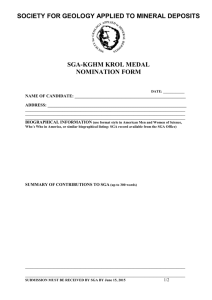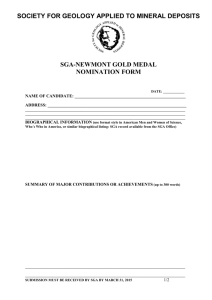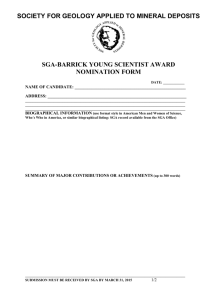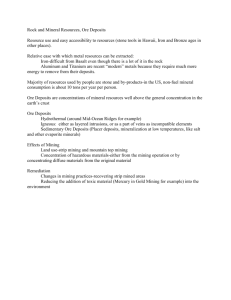Preface
advertisement
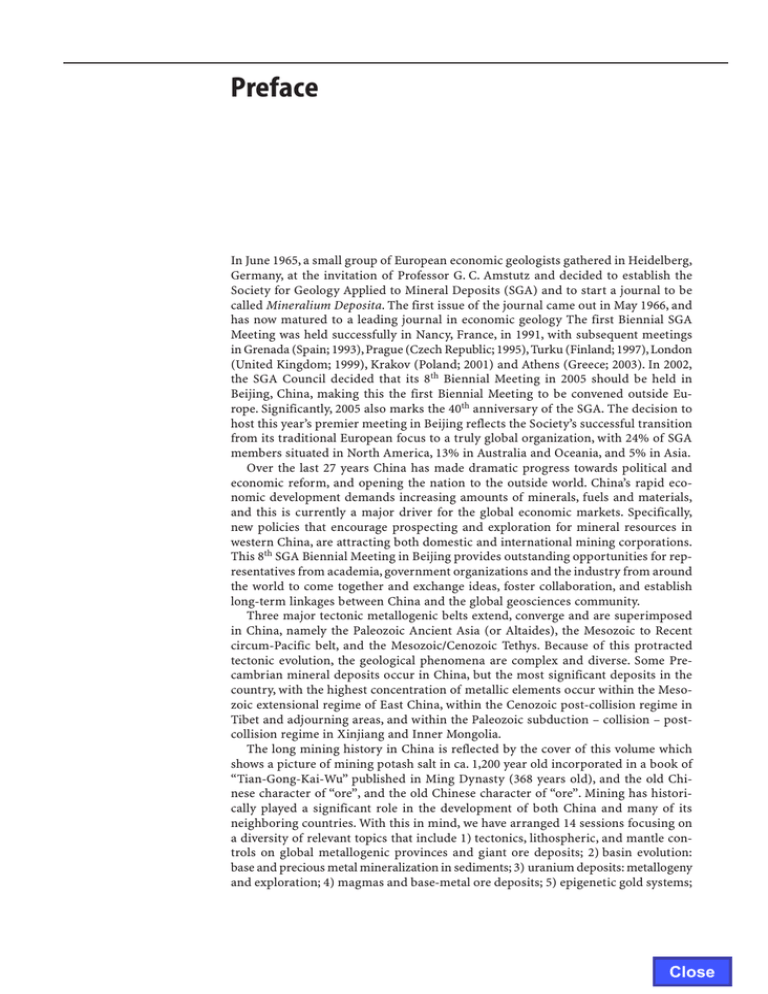
Preface In June 1965, a small group of European economic geologists gathered in Heidelberg, Germany, at the invitation of Professor G. C. Amstutz and decided to establish the Society for Geology Applied to Mineral Deposits (SGA) and to start a journal to be called Mineralium Deposita. The first issue of the journal came out in May 1966, and has now matured to a leading journal in economic geology The first Biennial SGA Meeting was held successfully in Nancy, France, in 1991, with subsequent meetings in Grenada (Spain; 1993), Prague (Czech Republic; 1995), Turku (Finland; 1997), London (United Kingdom; 1999), Krakov (Poland; 2001) and Athens (Greece; 2003). In 2002, the SGA Council decided that its 8th Biennial Meeting in 2005 should be held in Beijing, China, making this the first Biennial Meeting to be convened outside Europe. Significantly, 2005 also marks the 40th anniversary of the SGA. The decision to host this year’s premier meeting in Beijing reflects the Society’s successful transition from its traditional European focus to a truly global organization, with 24% of SGA members situated in North America, 13% in Australia and Oceania, and 5% in Asia. Over the last 27 years China has made dramatic progress towards political and economic reform, and opening the nation to the outside world. China’s rapid economic development demands increasing amounts of minerals, fuels and materials, and this is currently a major driver for the global economic markets. Specifically, new policies that encourage prospecting and exploration for mineral resources in western China, are attracting both domestic and international mining corporations. This 8th SGA Biennial Meeting in Beijing provides outstanding opportunities for representatives from academia, government organizations and the industry from around the world to come together and exchange ideas, foster collaboration, and establish long-term linkages between China and the global geosciences community. Three major tectonic metallogenic belts extend, converge and are superimposed in China, namely the Paleozoic Ancient Asia (or Altaides), the Mesozoic to Recent circum-Pacific belt, and the Mesozoic/Cenozoic Tethys. Because of this protracted tectonic evolution, the geological phenomena are complex and diverse. Some Precambrian mineral deposits occur in China, but the most significant deposits in the country, with the highest concentration of metallic elements occur within the Mesozoic extensional regime of East China, within the Cenozoic post-collision regime in Tibet and adjourning areas, and within the Paleozoic subduction – collision – postcollision regime in Xinjiang and Inner Mongolia. The long mining history in China is reflected by the cover of this volume which shows a picture of mining potash salt in ca. 1,200 year old incorporated in a book of “Tian-Gong-Kai-Wu” published in Ming Dynasty (368 years old), and the old Chinese character of “ore”, and the old Chinese character of “ore”. Mining has historically played a significant role in the development of both China and many of its neighboring countries. With this in mind, we have arranged 14 sessions focusing on a diversity of relevant topics that include 1) tectonics, lithospheric, and mantle controls on global metallogenic provinces and giant ore deposits; 2) basin evolution: base and precious metal mineralization in sediments; 3) uranium deposits: metallogeny and exploration; 4) magmas and base-metal ore deposits; 5) epigenetic gold systems; Close VI Preface 6) submarine ore systems and ancient analogues: global comparisons of VMS (sponsored by IGCP-502); 7) understanding ore systems through precise geochemistry, isotope tracing and microgeochemistry; 8) general economic geology; 9) Mesozoic to recent geodynamic and metallogeny of eastern Asia; 10) metallogeny of the TethysHimalayan orogen; 11) geodynamics and metallogeny of the Altaid orogen (sponsored by both IAGOD and IGCP-473); 12) metallogeny of the Au-Ag-Se-Te mineralized systems (sponsored by both IAGOD and IGCP-486); 13) conceptual targeting of mineral deposits; and 14) exploration, discovery, and mine developments in China (sponsored by SEG). Four short courses and workshops will be held prior to the meeting, i.e. 1) “geochemical mapping – regional national and global”; 2) “metallogeny: current theory and exploration models”; 3) “gold deposits: new development and exploration” (sponsored by SEG), and 4) “metallogeny of intrusion-related gold deposits in China and adjacent countries”. Another short course on magmatic sulfide deposits (“geology, geochemistry and exploration” will be offered following the meeting. Moreover, a total of 15 pre- and post-meeting field excursions have been organized. These field trips will provide the participants with unique opportunities to visit metallogenic provinces and important deposits in China, Mongolia, Japan, New Zealand, and Iran. The response to our invitation to meet in Beijing has been exceptional, with over 450 extended abstracts submitted by authors from 39 countries. Following review and editing of all submissions by ourselves and a panel of dedicated reviewers (cf. complete list of reviewers), 400 revised submissions were accepted and are included in this volume. These papers present a diverse and comprehensive snapshot of global mineral resources research and exploration at the beginning of the 21st century. On behalf of the Organizing Committee, we wish to express our sincere gratitude for the joint sponsorship of the following organizations: China University of Geosciences (Beijing); Institute of Mineral Resources, Chinese Academy of Geological Sciences; National Natural Science Foundation of China; China Society of Geology; Society of Economic Geologists (SEG); International Association on the Genesis of Ore Deposits (IAGOD); Institute of Geology and Geophysics, Chinese Academy of Sciences; Institute of Geochemistry, Chinese Academy of Sciences; and State Key Lab for Mineral Deposit Research, Nanjing University. More than sixty students from around the world and ten professionals from developing countries have received financial grants to assist their participation in the meeting. This was made possible by generous financial donations from 17 mining and exploration companies (Anglo American; Anglogold Ashanti China; BHP Billiton Word Exploration; De Beers; Goldfields Australia; Ivanhoe Mines; Newmont Mining; Oxiana Resources; Placer Dome Exploration; Rio Tinto London; Sino-Oz; Sino Gold; Silvercorp Metals Inc; SRK Consulting; Teck Cominco; Garrison International) and the Specialist Group in Economic Geology of the Geological Society of Australia. We are extremely grateful to all co-convenors involved in organizing the scientific sessions and for their editing of numerous papers with patience, tolerance and dedication. We also wish to thank the Organizing Committee for their enthusiasm and hard work that made this meeting possible and ensured its international recognition. We are confident this conference will be a milestone in the 40th anniversary year of our SGA and extend a warm welcome to all participants of the 8th Biennial SGA Meeting. Beijing, August 2005 Jingwen Mao, Frank Bierlein Close
